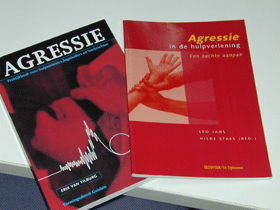(in Roeselare)
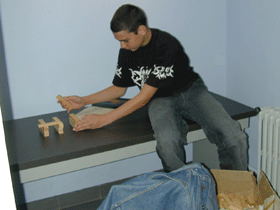
Time out room
(in Roeselare)
Since about 5 years our school has a time-out room worth the name at her disposal. All the work isn't done yet but nevertheless we can start with our therapeutic and pedagogical approach of certain problems; it's a story of trial and error, but also of a great deal of satisfaction now and then.
The infra-structure
An empty room changed into an oasis of peace, light and colour, all this with the help of the pupils of the woodwork department.
The square room, without any outside windows, is now divided into four separate spaces. One section of about 12 square metres serves as a therapy room; for this purpose a complete visual separation has to remain possible.
Besides there are two niches where one or two pupils can sit at a fixed table. Here they can cool down without being irritated, or perform a task.
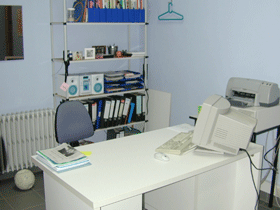 A
3rd open space where the therapist and/or assistant-teacher can sit. This is the
administration sector where the phone calls come in, and the intake takes place.
A
3rd open space where the therapist and/or assistant-teacher can sit. This is the
administration sector where the phone calls come in, and the intake takes place.
We provide in supporting material such as headphones in both niches where the pupils can listen to appropriate music. This prevents them to listen to a private conversation, or is used for the therapeutic effect.
The tables are fixed to avoid damage, or noise by moving them.
The pupils
can choose a ball or a chair to sit on. The positive side-effect of the ball is
the canalizing and neutralising of the surplus of energy by rocking on it.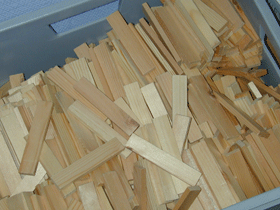
In the therapy-room there's a large table where several people can sit together. This is useful when victims and wrong-doers of bullying are brought together for a discussion.
I also provide in all kinds of "games" with the accent on focusing the attention, learning to finish something, coming to a result, creativity etc.; such as tangram, KAPLA-boards, mandala’s, puzzles, material to learn how to make knots..
For behavioural therapy, mirrors can be used, and a mattress to punch (or a punch-ball?).
We decided to choose natural lighting to compensate the lack of daylight. By putting full-spectrum lights in the fittings the quality and quantity of the light, including the healthy UV-radiation, looks practically the same as the full daylight. This is made possible through use of high quality materials, a colour temperature of 5500 K and a coating of six different phosphor powders. The colour reproduction-index is 96; for comparison, a standard, cool white fluorescence tube has 62, the regular daylight 100.
Because modern man lives inside for 80% of his time, this seems to be a very useful investment. It also has the additional advantage that concentration will increase, and through this, learning and working abilities will ameliorate too.
Physical and mental fatigue will decrease, together with headache and stress.
By using the full-spectrum lights the blue colour of the walls has the same intensity as plain daylight; the advantages of the colour blue intensify through this.
We chose blue because it provokes harmony and restores the balance. The nervous exaltation diminishes through its cooling, calming and sobering effect.
Blue has a few psychological effects too: it is more calming than green when there's an emotional problem occurring; it's also stimulating meditation and spiritual well-being.
Blue relaxes the spirit and controls the throat-chakra, the centre of creativity.
From the
blue surroundings the individual aims his attention at the outside world; thus
he becomes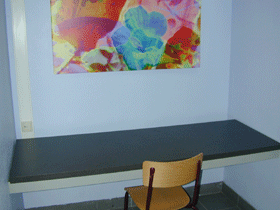 more aware of his environment and learns to deal with it in greater harmony.
more aware of his environment and learns to deal with it in greater harmony.
An introspective individual will come out of his shell.
Blue is also the colour of truth, dedication, quietness and sincerity; these are important values considering the purpose of the TO-room.
The colour blue however is even more effective in combination with other colours. Therefore "paintings", mostly in what we call the main colours, are hung on the walls. They can be changed according to the state of mind of the pupil.
In the TO-room we also use scents. We have the aroma- knowhow in the house: experiments in our institute showed that the aroma-therapy works on our population too; it can improve their behaviour. A few blends of etherical oils proofed to be successful; by vaporising these oils we create a "smell-scape" and as a result a relaxing and harmonic atmosphere. Recommendable!
We can surely put that the TO-room is an oasis of peace in the centre of a sometimes chaotic and hectic school-life. Passers-by are touched by the colour, the light and the aroma!
